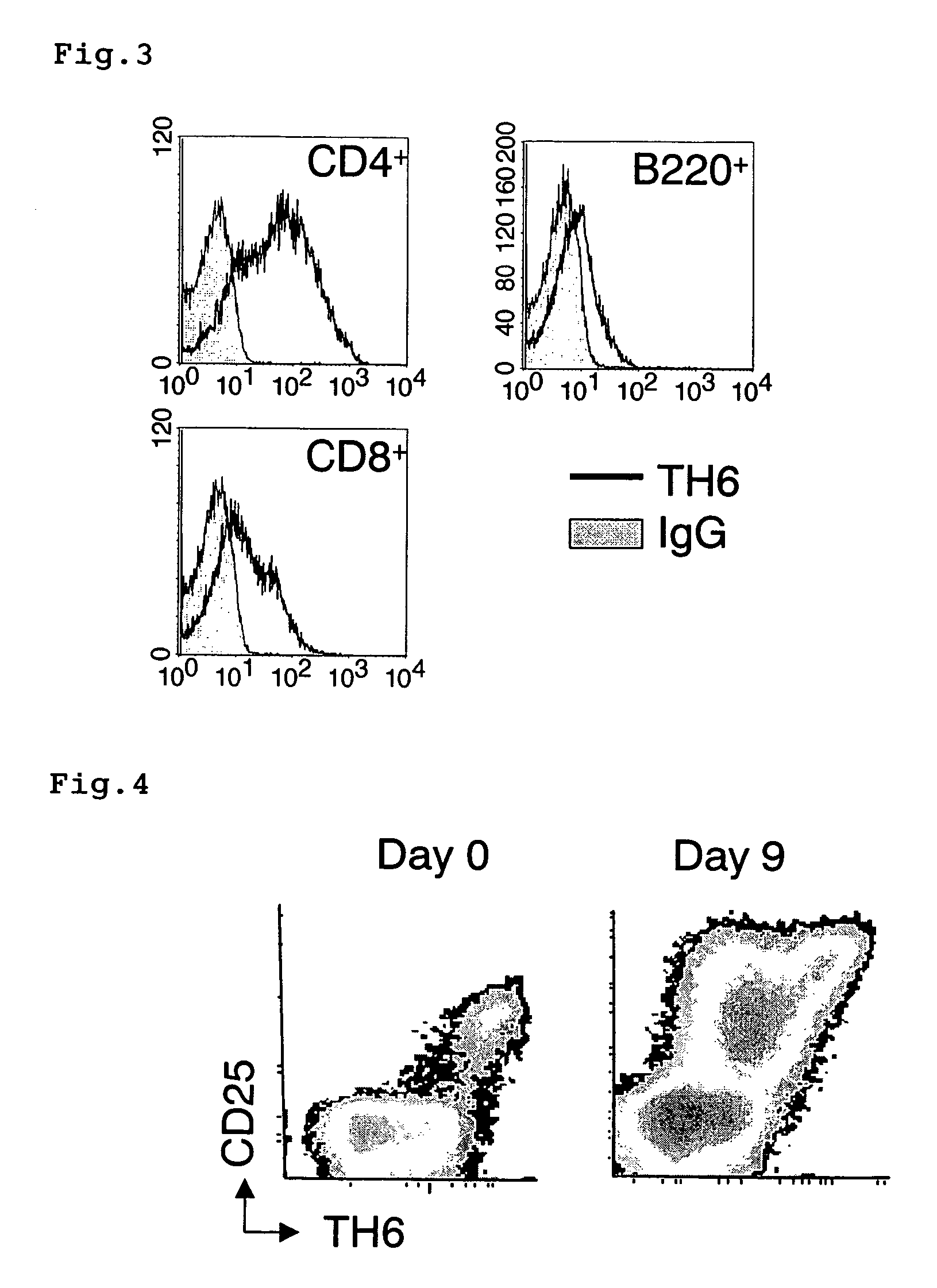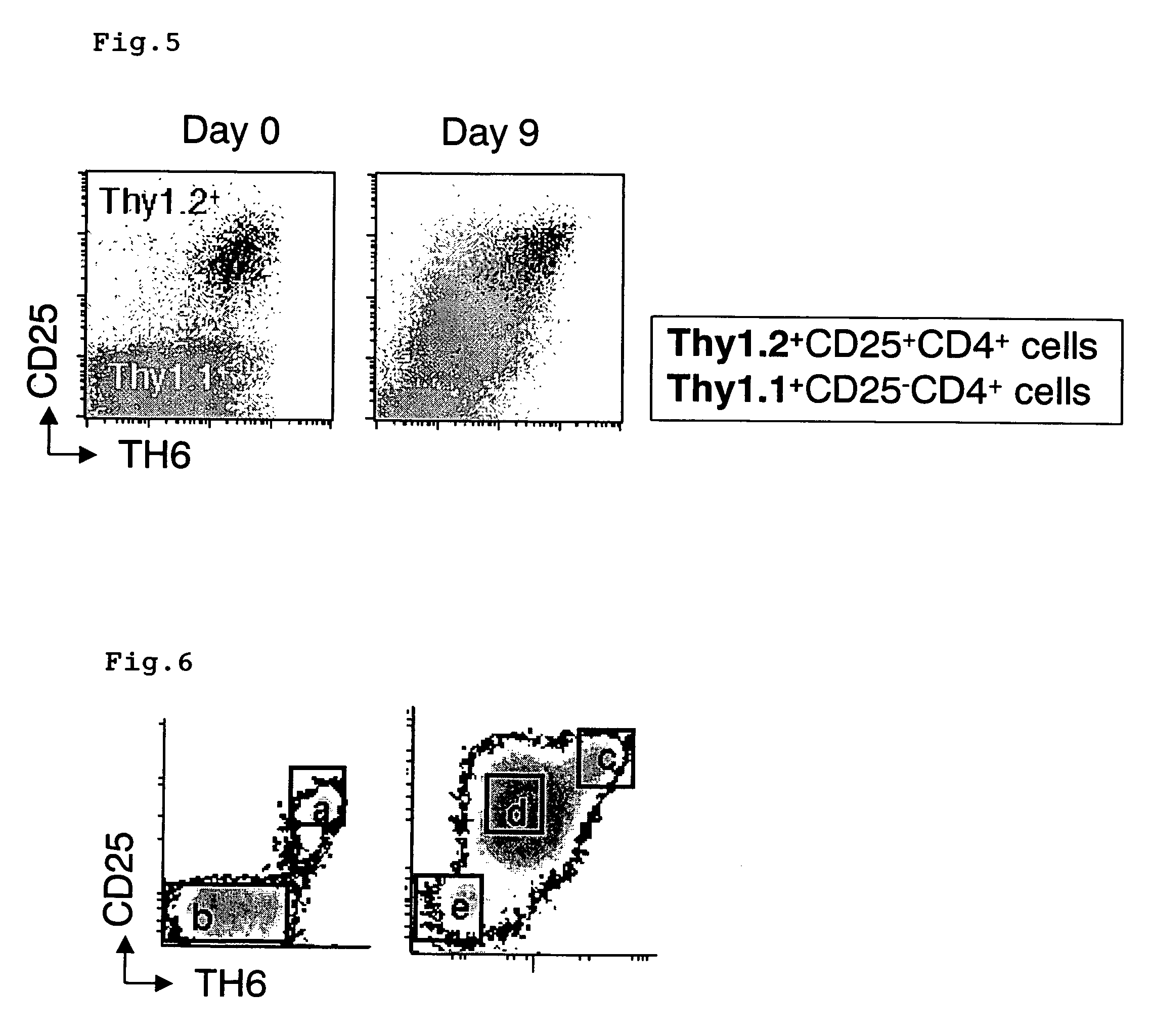Method for detecting regulatory T cells using expression of folate receptor 4 as indicator, method for treating diseases using the detection method, pharmaceutical composition for immunostimulation, and method for treating diseases using the composition
a technology of folate receptor and expression of t cells, applied in the direction of drug compositions, instruments, immunostimulation, etc., can solve the problems of inability to clinically use a t cell population from which tsub>reg /sub>cells have been removed, inability to express the immune response of activated t cells, and inability to isolate or remove tsub>reg /sub>cells, etc., to achieve the effect of re a t cell expression of regulatory t cell expression of folate receptor 4 expression of folate receptor 4 expression of folate receptor 4 expression of folate receptor 4 expression of folate receptor 4 expression of folate receptor 4 expression of folate receptor 4 expression of folate receptor 4 expression of folate receptor 4 expression of folate receptor 4 expression of folate receptor 4 expression of folate receptor 4 expression of folate receptor 4 expression of folate receptor 4 expression of folate receptor 4 method, method of treatment method, method of treatment method, method of drug substance substance,
- Summary
- Abstract
- Description
- Claims
- Application Information
AI Technical Summary
Benefits of technology
Problems solved by technology
Method used
Image
Examples
reference example 1
Preparation of Mouse Hybridoma Cells that Produce Anti-Folate Receptor 4 Antibody
[0102]First, CD25+CD4+ T cell strains for serving as an immunogen were prepared by the following method. Spleen / lymph-node cells derived from normal BALB / c mice were placed in an RPMI culture medium containing culture supernatant (a 8-fold dilution) of hybridoma J11d (anti-24CD antibody-producing cell, purchased from the American Type Culture Collection) and culture supernatant (a 10-fold dilution) of hybridoma 3.155 (anit-CD8 antibody-producing cell, purchased from the American Type Culture Collection), and allowed to stand on ice for 30 minutes. The spleen / lymph-node cells in the RPMI culture medium were put into 10 cm dishes (2 dishes per mouse) coated with anti-rat IgG caprine antibody (product of ICN Pharmaceuticals, 5 ml / dish of anti-rat IgG caprine antibody diluted to 5 μg / ml), and incubated at 4° C. for 30 minutes. The suspension cells were then collected as cells rich in CD4+ cells by a panning...
reference example 2
Preparation of Anti-Folate Receptor 4 Antibody (TH6 antibody)
[0105]The mouse hybridoma TH6 cells (5×106) obtained in Reference Example 1 were administered to the abdominal cavities of SCID mice (product of Clea Japan, Inc.), which are immunodeficient mice, and abdominal dropsy was extracted on day 10 and after from the injection. The extracted abdominal dropsy was subjected to centrifugation, cell components and the like were removed therefrom by being passed through a 0.45 μm filter (product of Millipore), and then the monoclonal antibody (TH6 antibody) was purified using Protein G column (product of Amersham Biosciences KK). Elution of monoclonal antibody from the column was conducted using 0.1 M glycine-HCl at pH 2.7. Thus-obtained solution of monoclonal antibody was subjected to dialysis with PBS using a dialysis membrane (Spectrum Laboratories, MWCO 12-14000) and filtration using 0.2 μm filter (product of Millipore), obtaining purified antibody.
reference example 3
Reaction Specificity of Anti-Folate Receptor 4 Antibody (TH6 Antibody)
[0106]A pMXS-IG vector (provided by the Institute of Medical Science, the University of Tokyo) obtained by incorporating full-length cDNAs of mouse folate receptor 4 (FLR4) into Plat-E cells that are subclone of human HEK293T cells (provided by the Institute of Medical Science, the University of Tokyo) or an empty pMXS-IG vector was subjected to transfection using Fugene 6 (Roche Molecular Biochemicals). Biotin-labeled TH6 antibody (labeled using an Amersham biotinization kit) or biotin-labeled IgG2b (product of PharMingen Company) was added to the cells (1×108 cells / ml) in such a manner that the content of the biotin-labeled TH6 antibody or biotin-labeled IgG2b became 1 μg / ml, and reacted on ice for 30 minutes. After washing, PE-labeled streptavidin (product of PharMingen Company) was added thereto in such a manner that the amount of the PE-labeled streptavidin became 0.5 μg / ml, reacted on ice for 30 minutes, and...
PUM
| Property | Measurement | Unit |
|---|---|---|
| axial length | aaaaa | aaaaa |
| axial length | aaaaa | aaaaa |
| pH | aaaaa | aaaaa |
Abstract
Description
Claims
Application Information
 Login to View More
Login to View More - R&D
- Intellectual Property
- Life Sciences
- Materials
- Tech Scout
- Unparalleled Data Quality
- Higher Quality Content
- 60% Fewer Hallucinations
Browse by: Latest US Patents, China's latest patents, Technical Efficacy Thesaurus, Application Domain, Technology Topic, Popular Technical Reports.
© 2025 PatSnap. All rights reserved.Legal|Privacy policy|Modern Slavery Act Transparency Statement|Sitemap|About US| Contact US: help@patsnap.com



